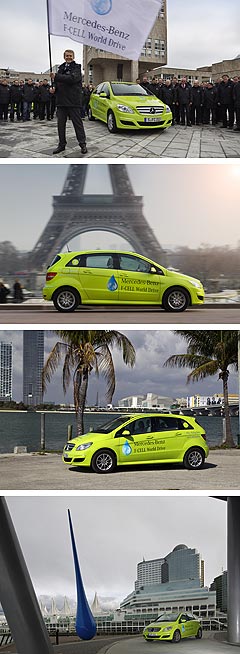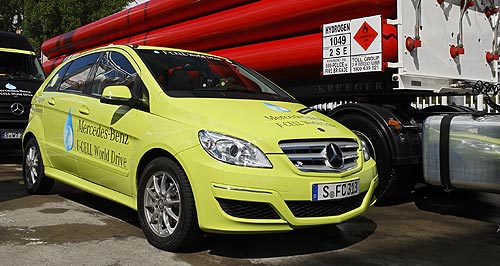Future models - Mercedes-Benz - F-CellBenz heralds hydro powerHydro on the Harbour: Mercedes-Benz global F-Cell roadshow begins its Australian leg. Mercedes’ 30,000km global fuel cell roadshow hits Oz, could cure EV woes.29 Mar 2011 By PHILIP LORD MERCEDES-BENZ says unresolved electric vehicle (EV) maladies including range anxiety and the inability to sustain heavy-duty loads can be cured in countries like Australia with hydrogen-powered fuel cell vehicles like its F-Cell hatchback concept. To prove its point, Mercedes has embarked on a 30,000km road show across four continents with three B-Class-based F-Cell fuel cell vehicles (FCVs) to promote the technology. The Australian leg of the well-publicised journey kicked off in Sydney yesterday, fresh from the USA. Next stop will be mainland China. The F-Cell is based on the sandwich-platformed B-Class, but in place of its internal combustion engine and conventional transmission are the now-familiar FCV ingredients of an electric motor, a hydrogen fuel stack and hydrogen storage tank. The set-up adds a 300kg burden to the B-class footprint, but most of this is carried lower than in the conventional B-class. Mercedes-Benz will build 200 F-Cell vehicles this year for leasing on three-year terms in the USA and Germany, in locations where public hydrogen filling stations are available. Mercedes-Benz, Toyota and Hyundai have announced they will have FCVs in series production in 2015, while BMW and Mazda already have hydrogen-powered internal combustion vehicles running in pilot programs in the USA, Germany and Norway. Mercedes-Benz is 11,000km into a 30,000km global road show with three B-Class FCVs to prove fuel-cell technology is accessible right now – but the armada of Mercedes support vehicles indicates the absurd gap in FCV technology and the infrastructure presently available to support it.  From top: The F-Cell roadshow kicks off in Stuttgart, sojourns through Paris, in Miami, on the way to Vancouver. From top: The F-Cell roadshow kicks off in Stuttgart, sojourns through Paris, in Miami, on the way to Vancouver.For the three F-Cells, there were another dozen support vehicles, including a Sprinter van filled with hydrogen pumping equipment, a large trailer-mounted generator to run the hydrogen pump and a hydrogen tanker to supply the hydrogen. There are just 200 hydrogen filling stations worldwide, but none in Australia – where hydrogen has been available commercially for years but where there is no political or business support to starting building them. So the Mercedes-Benz event is also a tour with a political agenda – that of lobbying for FCV infrastructure. The F-Cell has a badge on its rump identifying it as such, but aside from that (and the lurid green paint scheme and large graphics proclaiming its status) it could be any old B-class from the outside. Behind the wheel, a traditional instrument cluster soon reveals differences between the FCV and its internal combustion brothers the power gauge identifies whether your driving style is sucking power out of the fuel stack or regenerating power via the brakes or the electric motor on the overrun. It reminds one of a vacuum gauge in a VC-VH Holden Commodore, only in a more modern, electrified context. There are no paddle-shifters or other manual gear modes for racer-wannabes, either – the electric motor needs but one forward gear to drive through and it does so with its full torque from zero revs, as is the electric motor norm. Driving the left-hand drive F-Cell in built-up inner Sydney required familiarisation but the car’s lack of a conventional powertrain did not. It is an easy vehicle to drive, with plenty of torque that is delivered a lot more consistently than with a petrol or diesel engine. Mercedes says the biggest ongoing FCV engineering challenge it faces is hydrogen tank shape and packaging – the F-Cell stores fuel in three scuba tank-shape units. The cylindrical shape is necessary for containing high pressures but presents packaging inefficiencies, says Mercedes. Fuel cells could also be much more efficient, according to Mercedes, but the technology won’t be cheap. Mercedes says a price premium of just “a few thousand dollars” over an existing premium diesel hybrid (like those offered by Citroen in Europe) will buy into FCV ownership when its first FCVs roll off the production line in four years’ time. Precisely what form the series-production Mercedes-Benz FCV will take is not being discussed: the F-Cell’s platform will be superseded well before 2015 (the current B-class replacement will be shown for the first time later this year), so it will be “something else”, according to Mercedes. The company believes that traditional EVs have a place in densely populated areas, but Mercedes-Benz has hinted that the suitability of FCVs for longer distances such as those that separate Australian capital cities could mean that its 2015 FCV will emerge in the form of a larger vehicle than the B-class.  Read more |
Click to shareMercedes-Benz modelsResearch Mercedes-Benz Motor industry news |

















Facebook Twitter Instagram